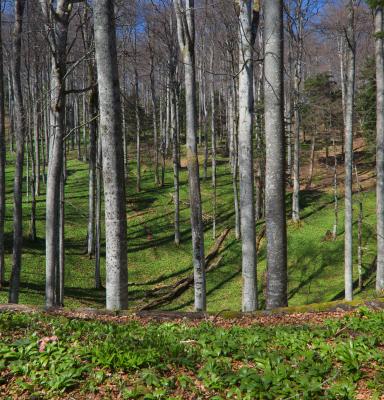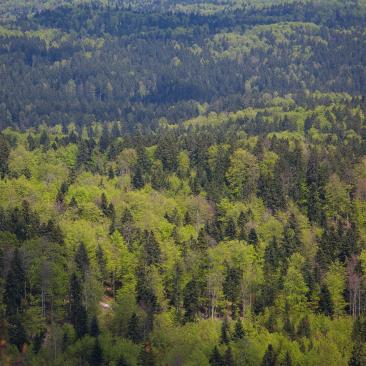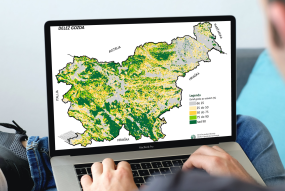

Forest area
Slovenian forests cover more than a half of the country (58%) and represent an essential landscape element. Such a high percentage of forest cover makes Slovenia the third most forested country within the European Union, right after Finland and Sweden. Forests take up 1 177 244 hectares and predominate on as much as three quarters of Slovenian territory. Sea surface takes less than 1% of the area and is represented by the blue colour on the graph below.

Forest expansion
There is significantly more forests today in Slovenia, then there was just a century ago. This is a great testimony to the responsible forest management being practised here and a long and proud forestry tradition of Slovenia. The first official national forest inventory in Slovenia was carried out in 1947 when forests amounted to 832 920 hectares. The graph below shows the forest cover as a percentage of the total surface of Slovenia over the years.

Forest use
According to the Law on Forests (Zakon o gozdovih), forests are classified according to their purpose into productive, protective and special purpose forests, which roughly defines the primary goal of forest management.

.

Productive forests are used for the production of forest products while preserving and improving their general useful functions.
There are 1 068 288 ha of productive forests in Slovenia (around 91%).

Protective forests are forests that protect land from sedimentation, washing and erosion, forests on steep slopes or water banks, forests that are exposed to strong winds, forests that hold back rapid runoff of water in torrential areas and therefore protect land from erosion and landslides, forest belts that protect forests and land from wind, water, and landslides, forests in agricultural and suburban landscapes with an extremely emphasised function of preserving biodiversity, and forests at the upper limit of forest vegetation.
There are 98 828 ha of protective forests in Slovenia (around 8%).

Special purpose forests with an extremely emphasised research function are forest reserves. These are forests that, due to their developmental stage and development to date, are extremely important for research, study and monitoring of the natural development of forests, biodiversity and the protection of natural values and cultural heritage.
There are 9 426 ha of special purpose forests in Slovenia (less than 1%).
Wood stock

The wood stock of the Republic of Slovenia equals to 386 136 000 m3, where broadleaf species (56% of the total Slovenian woodstock) are slightly more represented compared to conifers (44% of the total Slovenian woodstock) .
Fagus sylvatica, or European beech, is one of the most important and widespread broadleaved trees in Europe. It is a large deciduous tree that can maintain its high growth rate until late maturity. Its natural range extends from southern Scandinavia to Sicily, from Spain in the west to northwest Turkey in the east. Its wood is strong and wears well making it ideal for a wide range of uses, from furniture to musical instruments, as well as for pulp and firewood.
Picea abies, or Norway spruce, is a species of spruce native to Northern, Central and Eastern Europe. It has branchlets that typically hang downwards, and the largest cones of any spruce, 9–17 cm long. The Norway spruce has a wide distribution for it being planted for its wood, and is the species used as the main Christmas tree in several countries around the world. It is used in forestry for (softwood) timber and paper production.
Increment and allowed harvest
The annual increment in Slovenian forests amounts to 9 488 000 m3, while the increment per hectare per year is around 7,86 m3. The annual increment of conifers amounts to 4 226 000 m3, while the annual increment of broadleaf species is higher at 5 262 000 m3.
Forest management plans determine the conditions for the coordinated use of forests and encroachment on forests and forest space, as well as the highest possible level of their exploitation (allowed harvest), which is determined within the framework of the forest management unit within the framework of descriptions of stands for the next decade. Below presented allowed cut (around 7 M m3) represents a tenth of the sum of the determined ten-year allowed cuts of all currently valid forest management plans.

It is good to note that the allowed annual cut, which is based on long term planning, does not necessarily have to coincide with the actually realised annual cut. For example, in 2021, only 4 075 451 m3 of woodstock has been harvested in Slovenia, which is about 57% of possible allowed cut for that year.
Forest ownership
Slovenia is the only country in the Adria-Balkan Region, which has 3 forest ownership categories. Beside the private and state forest ownership, in Slovenia there is also local community forest ownership (represented on the graph below with a blue colour, it amounts to 3%). Furthermore, of all the countries in the Adria-Balkan Region, Slovenia has the highest share of privately owned forests.

Ownership of forests has changed in recent years mainly due to denationalisation procedures (forest restitution). Thus, since 1996, the area of state forests decreased by 130,771 ha (from 369,344 ha), while the area of private forests increased by 188,109 ha (from 719,544 ha). The ratio of the area of state and private forests (together with municipal forests) has changed since 1996 from 34:66 in 1996 to 20:80 in 2021.
Forest management
Contemporary, close-to-nature forestry in Slovenia combines different silvicultural tools that can be broadly classified into three silvicultural systems:
- irregular shelterwood,
- selection, and
- free-style silviculture.
Close-to-nature silviculture developed as a response to forest degradation and clearcut management. It is science-based and practically oriented, focused on mimicking natural processes and combining different felling regimes; the main aims are dedicated to forest continuity and permanent improvement of forests by tending.
All three silvicultural systems used in Slovenia are based on leading principle of forest tending, which represents gradual continuos improvement of individual crop trees, forest stands and sites, they also advocate a holistic approach to complex forest ecosystems. In strict compliance with the principle of tending, the free combination of different types of felling is permitted, so the silvicultural system is adjusted to a unique combination of the sites's requirement.
Several guiding principles are applied:
- the use of natural regeneration and native tree species,
- following natural processes and mimicking historical disturbance regimes,
- favouring complex vertical and horizontal forest structures, and
- respecting tree individuality.
In Slovenia this is the predominating system.
Irregular shelterwood approach involves assessing the responses of adult stands creating a favourable climate for successful regeneration by constant evolution of the tree responses to the silvicultural measures applied. Unlike the regular shelterwood system, this system requires close cooperation with silvicultural planning, and no longer follows a strict spatial order. Both care and tending are used at the same time in all development phases, which are present on a small surface and provide with their diversity a greater stability of the stand. Cutting is adapted and more detailed, with a lower intensity. Regeneration is carefully planned on location. Logging is planned to provide minimal injuries.
Natural regeneration of tree species is constantly present in all older development phases of the forest. The rotation period introduced by regular system is defined individually and refers primarily to the economic suitability of the stand regeneration, and thus the cutting of adult trees, which is species and site specific. The share of development phases is balanced, towards the permanent provision of silvicultural and other objectives and functions of the stand on small surface areas.
In the selection method forest trees of all dimensions are represented on a small surface area, ensuring sustainable production and conservation of the sites's potential. Regeneration is continuos, and the growth and development of threes are more individualised compare to the irregular shelterwood system. The canopy cover is not continuous, but variable, multi-layered and following a stepwise structure. A fifth of the forests in Croatia is also managed according to this method.
In the social ascent of trees, the overgrowing of individual trees appears when the light conditions or the release of competitors allows the passage from one to the other layer. In the selection stands we may define the various stand positions of the forest tree as follows:
- the position of suppressed, waiting individuals is characterised by shady microsites, where height growth is suppressed, and only the most vigorous individuals survive. Shade tolerant species like silver fir could dwell in this position for more than hundred of years.
- the position of runners is indicated by smaller gaps and light shafts, where height growth is rapidly increased due to the increased light environment or release of the competitors.
- the position of winners or carriers marks the point when the social ascent is completed, and a long period of stable, unsuppressed height and radial growth is initiated.
This forest management system is not suitable for all tree species and all sites, it is more adapted to shade tolerant species that thrive in modest light conditions - especially for conifers (spruce and fir). The selection method is more demanding in the case of broadleaves (beech and oak), especially due to unwanted forms of growth and poor assortment quality if the light is not sufficient - leading to high associated costs.
Free silvicultural approach is one of the youngest and it includes the principles of plentering, selection and irregular shelterwood systems. It is characterised by the free choice of silvicultural measures but requires a lot of professional competence and consistency. It is suitable for all types of sites and stands, but most of all in cases where we can not only consider the principles of irregluar shelterwood or plentering alone: it may be applied on degraded and changed stands, where there are problems associated with inappropriate former management or in degraded or declining forests, where site and stand conditions require great flexibility with regard to the silvicultural approaches adopted. It combines elements of various approaches on small surface areas and requires careful and demanding planning according to the established management objectives.
Tending measures are applied in all stand development phases. The goal of each development phase is its next stage, where their characteristics and properties are described in detail - the quality, the structure and the possible peculiarities of the site.
- In the youngest development stage direct tending is performed to protect saplings in the herbal layer by regulating the species admixture and cleaning.
- By cleaning the dense young forest (2-3m in height) a mass of quality individuals is selected and the conditions for social ascent are provided. Future quality is increased by removal of overgrown and branched trees, and by thus reducing the density greater mechanical stability is provided.
- After stratification in the former stage is finished and the economically interesting properties of individuals begin to appear, we start to perform selective thinning to stimulate growth, as the growing space is restricted. The former mass selection progressively transforms to selected groups and/or responsive individuals. The frequency of thinning is species and site specific.
Promotional video
A presentation film on forests and forestry in Slovenia, which was created in the project of generic promotion of forests and forestry of the Forest Fund at the Ministry of Agriculture, Forestry and Food of the Republic of Slovenia for the needs of the Slovenian Presidency of the Council of the EU.
© Ministry of Agriculture, Forestry and Food of the Republic of Slovenia, 2021
Additional resources

Forest Report 2021
To read more about the current state and future forest management in Slovenia, please access the original Forest Report prepared by the Forest Institute of Slovenia.

Slovenian forests on the map
Access the great library of maps showing various aspects of forests in Slovenia as well as species distribution.
